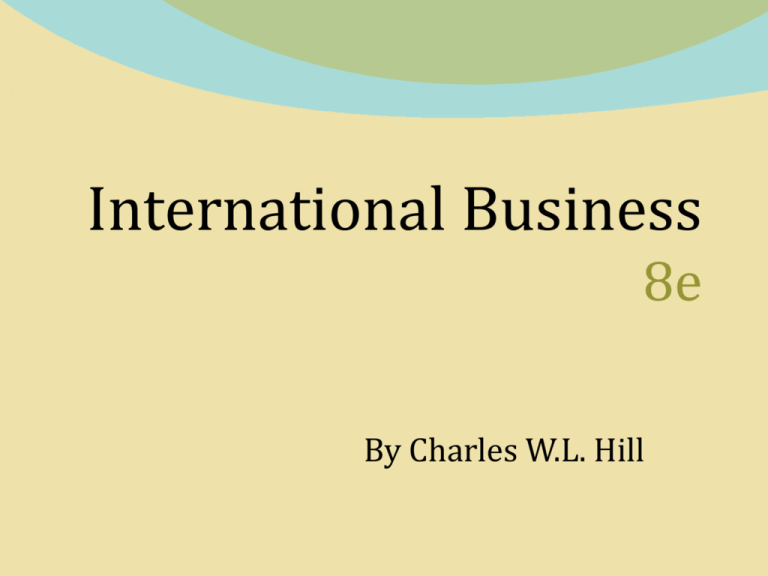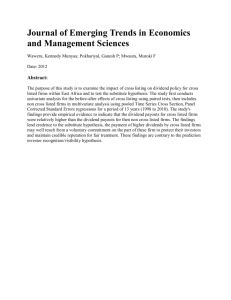
International Business
8e
By Charles W.L. Hill
Chapter 20
Financial Management
in the International
Business
McGraw-Hill/Irwin
Copyright © 2011 by the McGraw-Hill Companies, Inc. All rights reserved.
What Is
Financial Management?
Financial management involves
1. Investment decisions –what to finance
2. Financing decisions –how to finance those decisions
3. Money management decisions –how to manage the firm’s
financial resources most efficiently
Good financial management can create a competitive
advantage
reduces the costs of creating value and adds value by improving
customer service
Decisions are more complex in international business
different currencies, tax regimes, regulations on capital flows,
economic and political risk, etc.
20-3
How Do Managers Make
Investment Decisions?
Financial managers must quantify the benefits,
costs, and risks associated with an investment in a
foreign country
To do this, managers use capital budgeting
involves estimating the cash flows associated with the
project over time, and then discounting them to
determine their net present value
If the net present value of the discounted cash
flows is greater than zero, the firm should go
ahead with the project
20-4
Why Is Capital Budgeting More
Difficult For International Firms?
Capital budgeting is more complicated in
international business
because a distinction must be made between
cash flows to the project and cash flows to the
parent company
because of political and economic risk
because the connection between cash flows to
the parent and the source of financing must be
recognized
20-5
What Is The Difference Between
Project And Parent Cash Flows?
Cash flows to the project and cash flows to the
parent company can be quite different
Parent companies are interested in the cash flows
they will receive, not the cash flows the project
generates
received cash flows are the basis for dividends, other
investments, repayment of debt, and so on
Cash flows to the parent may be lower because of
host country limits on the repatriation of profits,
host country local reinvestment requirements, etc.
20-6
How Does Political Risk
Influence Investment Decisions?
Political risk - the likelihood that political forces
will cause drastic changes in a country’s business
environment that hurt the profit and other goals of
a business
higher in countries with social unrest or disorder, or
where the nature of the society increases the chance for
social unrest
Political change can result in the expropriation of a
firm’s assets, or complete economic collapse that
renders a firm’s assets worthless
20-7
How Does Economic Risk
Influence Investment Decisions?
Economic risk - the likelihood that
economic mismanagement will cause
drastic changes in a country’s business
environment that hurt the profit and other
goals of a business
The biggest economic risk is inflation
reflected in falling currency values and lower
project cash flows
20-8
How Can Firms Adjust For
Political And Economic Risk?
Firms analyzing foreign investment
opportunities can adjust for risk
1. By raising the discount rate in countries
where political and economic risk is high
2. By lowering future cash flow estimates to
account for adverse political or economic
changes that could occur in the future
20-9
How Do Firms Make
Financing Decisions?
1.
Firms must consider two factors
How the foreign investment will be financed
2.
How the financial structure (debt vs. equity) of the
foreign affiliate should be configured
the cost of capital is usually lowest in the global capital market
but, some governments require local debt or equity financing
firms that anticipate a depreciation of the local currency, may
prefer local debt financing
need to decide whether to adopt local capital structure norms or
maintain the structure used in the home country
Most experts suggest that firms adopt the structure that
minimizes the cost of capital, whatever that may be
20-10
What Is Global
Money Management?
Money management decisions attempt to
manage global cash resources efficiently
Firms need to
1. Minimize cash balances - need cash balances
on hand for notes payable and unexpected
demands
cash reserves are usually invested in money market
accounts that offer low rates of interest
when firms invest in money market accounts they
have unlimited liquidity, but low interest rates
when they invest in long-term instruments they have
higher interest rates, but low liquidity
20-11
What Is Global
Money Management?
2. Reduce transaction costs - the cost of exchange
every time a firm changes cash from one currency to
another, they face transaction costs
Most banks also charge a transfer fee for
moving cash from one location to another
Multilateral netting can reduce the number of
transactions between subsidiaries and the
number of transaction costs
20-12
How Can Firms Limit
Their Tax Liability?
Every country has its own tax policies
most countries feel they have the right to tax
the foreign-earned income of companies based
in the country
Double taxation occurs when the income
of a foreign subsidiary is taxed by the hostcountry government and by the homecountry government
20-13
How Can Firms Limit
Their Tax Liability?
Taxes can be minimized through
1. Tax credits - allow the firm to reduce the taxes paid to
the home government by the amount of taxes paid to
the foreign government
2. Tax treaties - agreement specifying what items of
income will be taxed by the authorities of the country
where the income is earned
3. Deferral principle - specifies that parent companies
are not taxed on foreign source income until they
actually receive a dividend
4. Tax havens - countries with a very low, or no, income
tax – firms can avoid income taxes by establishing a
wholly-owned, non-operating subsidiary in the country
20-14
How Do Corporate
Tax Rates Compare?
Corporate Income Tax Rates, 2006
20-15
How Do Firms Move
Money Across Borders?
Firms can transfer liquid funds across
border via
1.
2.
3.
4.
Dividend remittances
Royalty payments and fees
Transfer prices
Fronting loans
Firms that use more than one of these
techniques are unbundling
20-16
What Are
Dividend Remittances?
Paying dividends is the most common method of
transferring funds from subsidiaries to the parent
The relative attractiveness of paying dividends
varies according to
tax regulations – high tax rates make this less attractive
foreign exchange risk – dividends might speed up in
risky countries
the age of the subsidiary – older subsidiaries remit a
higher proportion of their earning in dividends
the extent of local equity participation – local owners’
demands for dividends come into play
20-17
What Are
Royalty Payments And Fees?
Royalties - the remuneration paid to the owners of
technology, patents, or trade names for the use of that
technology or the right to manufacture and/or sell
products under those patents or trade names
can be levied as a fixed amount per unit or as a percentage of gross
revenues
most parent companies charge subsidiaries royalties for the
technology, patents or trade names transferred to them
A fee is compensation for professional services or
expertise supplied to a foreign subsidiary by the parent
company or another subsidiary
royalties and fees are often tax-deductible locally
20-18
What Are Transfer Prices?
Transfer prices - the price at which goods and
services are transferred between entities within
the firm
Transfer prices can be manipulated to
1. Reduce tax liabilities by shifting earnings from high-tax
countries to low-tax countries
2. Move funds out of a country where a significant
currency devaluation is expected
3. Move funds from a subsidiary to the parent when
dividends are restricted by the host government
4. Reduce import duties when ad valorem tariffs are in
effect
20-19
What Makes
Transfer Prices Unattractive?
But, using transfer pricing can be
problematic because
1. Governments think they are being cheated out
of legitimate income
2. Governments believe firms are breaking the
spirit of the law when transfer prices are used
to circumvent restrictions of capital flows
3. It complicates management incentives and
performance evaluation
20-20
What Are Fronting Loans?
Fronting loans are loans between a parent
and its subsidiary channeled through a
financial intermediary, usually a large
international bank
Firms use fronting loans
to circumvent host-country restrictions on the
remittance of funds from a foreign subsidiary to
the parent company
to gain tax advantages
20-21
What Are Fronting Loans?
An Example of the Tax Aspects of a Fronting Loan
20-22
How Do Firms Manage
Global Cash Resources?
1.
Firms manage their global cash resources using
Centralized depositories
Holding cash balances at a centralized depository is
attractive because
by pooling cash reserves centrally, firms can deposit larger
amounts, and therefore earn higher rates of interest
when centralized depositories are located in major financial
centers, the firm has access to a greater variety of investment
opportunities than a subsidiary would have
by pooling cash reserves, firms can reduce the total size of the
readily accessible cash pool, and invest larger amounts in longerterm, less liquid accounts that have higher interest rates
20-23
How Do Firms Manage
Global Cash Resources?
But, centralized depositories can be unattractive
because of
government restrictions on cross-border capital flows
the transaction costs involved in moving money in and
out
The use of centralized depositories is expected to
increase because of the globalization of capital
markets and the removal of barriers to the free
flow of capital across borders
20-24
How Do Firms Manage
Global Cash Resources?
2. Multilateral netting - can reduce the
transaction costs associated with many
transactions between subsidiaries
an extension of bilateral netting
if a French subsidiary owes a Mexican subsidiary $6 million,
and the Mexican subsidiary simultaneously owes the French
subsidiary $4 million, a bilateral settlement will be made with
a single payment of $2 million
Under multilateral netting, the concept is
extended to multiple subsidiaries within an
international business
20-25
What Is Multilateral Netting?
Cash Flows Before Multilateral Netting
20-26
What Is Multilateral Netting?
Calculation of Net Receipts (millions)
20-27
What Is Multilateral Netting?
Cash Flows After Multilateral Netting
20-28
Review Question
Which of the following is not one of the
decision areas in financial management?
a) cash operations decisions
b) investment decisions
c) financing decisions
d) money management decisions
20-29
Review Question
The fee for moving cash from one location to
another is called
a) the money management fee
b) the transaction cost
c) the transfer fee
d) the cost of capital
20-30
Review Question
Compared to the other countries, corporate
income tax rates in ________ are relatively low.
a) Canada
b) Ireland
c) Germany
d) Japan
20-31
Review Question
A __________ specifies that parent companies
are not taxed on foreign source income until
they actually receive a dividend.
a) tax credit
b) deferral principle
c) tax haven
d) tax treaty
20-32
Review Question
Firms can transfer liquid funds across borders
using all of the following techniques except
a) dividend remittances
b) royalty payments and fees
c) transfer prices
d) backing loans
20-33
Review Question
The most common method of transferring
funds from subsidiaries to the parent is
through
a) dividend remittances
b) royalty payments and fees
c) transfer prices
d) backing loans
20-34











